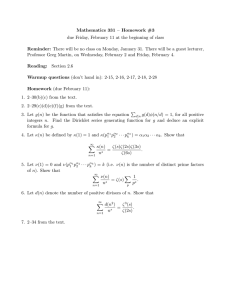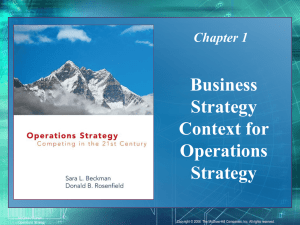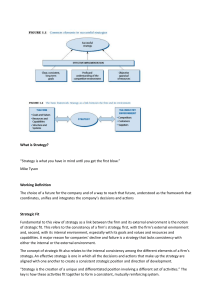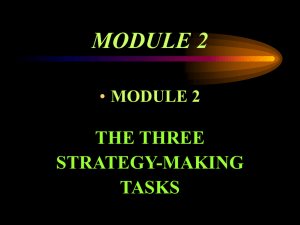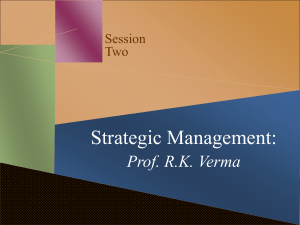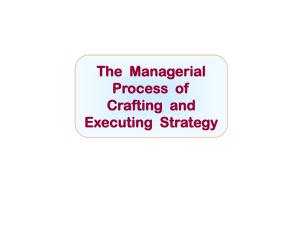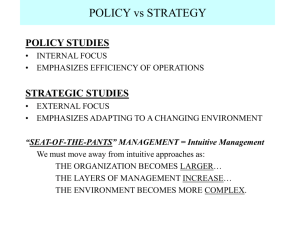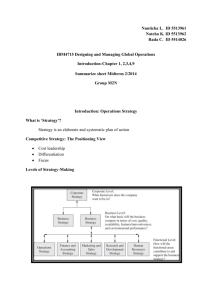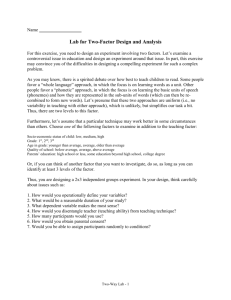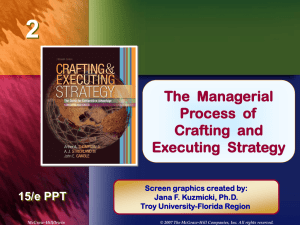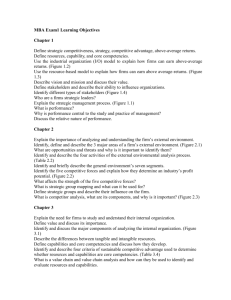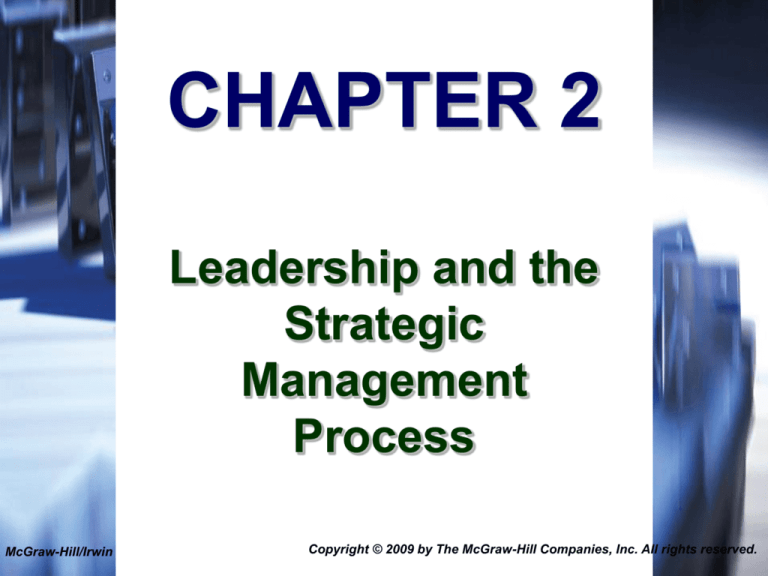
CHAPTER 2
Leadership and the
Strategic
Management
Process
McGraw-Hill/Irwin
Copyright © 2009 by The McGraw-Hill Companies, Inc. All rights reserved.
1-1
The Strategy-Making, Strategy-Executing
Process
2-2
2-2
Revised: Seven Tasks of
Strategic management
Mission/Vision
Goals/Objectives
Internal Analysis
External Analysis
Craft Strategy
Implement Strategy
Evaluation
2-3
2-3
Key Elements of a Strategic
Vision
Provides a panoramic view of
“where we are going”
Is distinctive and specific to a
particular organization
Avoids use of
generic language
that is dull and
that could apply
to most any company
2-4
2-4
Strategic Vision vs. Mission
A strategic
vision concerns a
firm’s future
business path “where
we are going”
Markets to be pursued
Future
product/market/
customer/technology
focus
2-5
The mission
statement of a
firm focuses on its
present business
purpose - “who
we are and what
we do”
Current product and
service offerings
Customer needs
being served
2-5
Payoffs of a Clear Strategic
Vision
Crystallizes an organization’s long-term
direction
Reduces risk of rudderless decisionmaking
Creates a committed enterprise to
make the vision a reality
Provides a beacon to keep strategy-related
actions of all managers on common path
Helps an organization prepare for the
future
2-6
2-6
Characteristics of Effectively
Worded Vision Statements
Graphic—Paints a picture of the
kind of company that management
is trying to create
Directional—Is forward looking
Focused—Is specific enough to
provide guidance in decision
making
Flexible—Is not so focused that it
makes it difficult to adjust to change
2-7
2-7
Characteristics of Effectively
Worded Vision Statements
Feasible—Is within the real of
what is possible
Desirable—Indicates why the
directional path makes sense
Easy to Communicate—Can
be explained in simple terms
2-8
2-8
Example of a Strategic Vision
Provide a global trading platform where
practically anyone can trade practically
anything.
2-9
2-9
Example of a Mission Statement
To give our customers the best food and beverage
values that they can find anywhere and to provide
them with the information required for informed
buying decisions. We provide these with a
dedication to the highest quality of customer
satisfaction delivered with a sense of warmth,
friendliness, fun, individual pride, and company
spirit.
2-10
2-10
Setting Objectives
Purpose of setting objectives
Converts vision into specific
performance targets
Creates yardsticks to track
performance
Well-stated objectives are
Quantifiable
Measurable
Contain a deadline for achievement
2-11
2-11
The Need for a Balanced
Scorecard
Achieving good financial performance
is not enough
Current financial results are “lagging
indicators” reflecting results of past
decisions and actions
Good strategic performance is thus a
“leading indicator” of a company’s
capability to deliver improved future
financial performance
2-12
2-12
Balanced Scorecard Objectives
Financial
Objectives
Strategic
Objectives
Customer
Outcomes focused
on improving
Value creation
Financial
Learning and Growth
Internal Processes
Value creating processes
Aligning organizational,
information, and human
capital with strategy
Performance
2-13
2-13
Examples of Financial
Objectives
X % increase in annual
revenues
X % increase annually in
after-tax profits
Profit margins of X %
X % return on capital
employed (ROCE)
Sufficient internal cash
flows to fund 100% of
new capital investment
2-14
2-14
Examples of Strategic
Objectives
Customer
Winning an X % market share
Achieving a customer retention rate of X %
Acquire X number of new customers
Internal Processes
Reduce product defects to X %
Introduction of X number of new products in
the next three years
Learning and Growth
Increase employee training to X hours/year
Reduce turnover to X % per year
2-15
2-15
Short-Term vs.
Long-Term Objectives
Short-term objectives
Targets to be achieved soon
Milestones or stair steps for reaching
long-range performance
Long-term objectives
Targets to be achieved within 3 to 5
years
2-16
2-16
Objectives Are Needed at All
Levels
1. First, set business-level objectives
2. Next, establish functional-area
objectives
3. Then, operating-level objectives are
established last
2-17
2-17
Crafting a Strategy
Strategy Making Hierarchy for
a Single Business Company
2-18
2-18
Levels of Strategy-Making
in a Diversified Company
Corporate-Level
Managers
Corporate
Strategy
Two-Way Influence
Business-Level
Managers
Business Strategies
Functional
Managers
Two-Way Influence
Functional Strategies
2-19
2-19
Levels of Strategy-Making in
a Single-Business Company
Business-Level
Managers
Business
Strategy
Two-Way Influence
Functional
Managers
Functional Strategies
2-20
2-20
Uniting the Company’s
Strategy-Making Effort
A firm’s strategy is a collection of
initiatives undertaken by managers
at all levels
in the organizational hierarchy
Pieces of strategy
should fit together
like the pieces
of a puzzle
2-21
2-21

